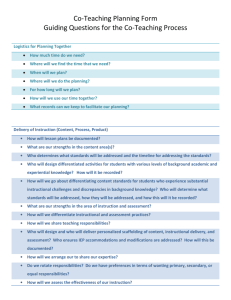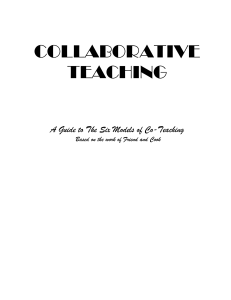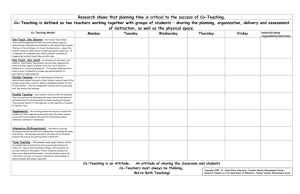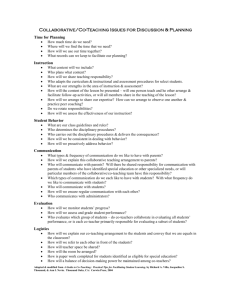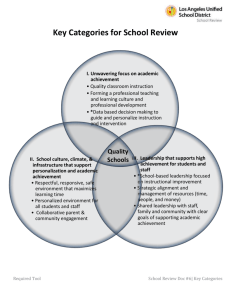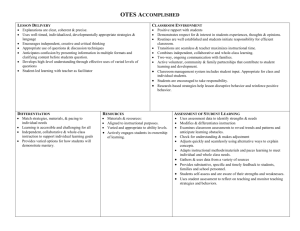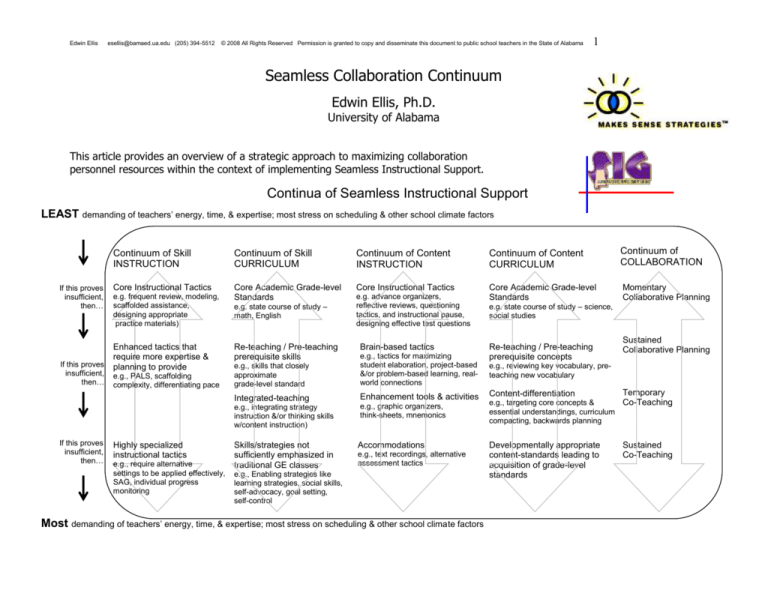
Edwin Ellis
esellis@bamaed.ua.edu (205) 394-5512
© 2008 All Rights Reserved Permission is granted to copy and disseminate this document to public school teachers in the State of Alabama
1
Seamless Collaboration Continuum
Edwin Ellis, Ph.D.
University of Alabama
This article provides an overview of a strategic approach to maximizing collaboration
personnel resources within the context of implementing Seamless Instructional Support.
Continua of Seamless Instructional Support
LEAST demanding of teachers’ energy, time, & expertise; most stress on scheduling & other school climate factors
If this proves
insufficient,
then…
If this proves
insufficient,
then…
If this proves
insufficient,
then…
Continuum of Skill
INSTRUCTION
Continuum of Skill
CURRICULUM
Continuum of Content
INSTRUCTION
Continuum of Content
CURRICULUM
Continuum of
COLLABORATION
Core Instructional Tactics
Core Academic Grade-level
Standards
Core Instructional Tactics
Core Academic Grade-level
Standards
Momentary
Collaborative Planning
e.g. frequent review, modeling,
scaffolded assistance,
designing appropriate
practice materials)
Enhanced tactics that
require more expertise &
planning to provide
e.g., PALS, scaffolding
complexity, differentiating pace
Highly specialized
instructional tactics
e.g., require alternative
settings to be applied effectively,
SAG, individual progress
monitoring
e.g. state course of study –
math, English
Re-teaching / Pre-teaching
prerequisite skills
e.g. advance organizers,
reflective reviews, questioning
tactics, and instructional pause,
designing effective test questions
Brain-based tactics
e.g., skills that closely
approximate
grade-level standard
e.g., tactics for maximizing
student elaboration, project-based
&/or problem-based learning, realworld connections
Integrated-teaching
Enhancement tools & activities
e.g., integrating strategy
instruction &/or thinking skills
w/content instruction)
e.g., graphic organizers,
think-sheets, mnemonics
Skills/strategies not
sufficiently emphasized in
traditional GE classes
Accommodations
e.g., text recordings, alternative
assessment tactics
e.g., Enabling strategies like
learning strategies, social skills,
self-advocacy, goal setting,
self-control
Most demanding of teachers’ energy, time, & expertise; most stress on scheduling & other school climate factors
e.g. state course of study – science,
social studies
Re-teaching / Pre-teaching
prerequisite concepts
Sustained
Collaborative Planning
e.g., reviewing key vocabulary, preteaching new vocabulary
Content-differentiation
Temporary
Co-Teaching
e.g., targeting core concepts &
essential understandings, curriculum
compacting, backwards planning
Developmentally appropriate
content-standards leading to
acquisition of grade-level
standards
Sustained
Co-Teaching
Edwin Ellis
esellis@bamaed.ua.edu (205) 394-5512
© 2008 All Rights Reserved Permission is granted to copy and disseminate this document to public school teachers in the State of Alabama
2
Seamless Instructional Support
(SIS) arranges instructional
tactics and services into a
continuum for providing
interventions for all students
who are not responding
adequately to traditional
instruction. Instructional
support is provided via a system
of layered support, with each
layer reflecting increasingly
more intensive instruction, more
sophisticated instructional tools,
adjustments in curriculum, and
in the nature and extent of
collaboration that occurs among
professionals on the student’s
behalf (see Figure 1). The intent
is to provide a proactive
approach to providing support
across a continuum of services
that reflect a least-to-most
intensive, least-to-most
intrusive, least-to-most
demanding of teachers’ time
and energy, and divergentfrom-normal-to-rarely-used
forms of support.
There are a range of collaborative processes that fall on a continuum of relatively simple-to-use to those that are complex and
require significant amounts of expertise, time, and teacher-energy to use. Likewise, when considering the long-term impact of GE/SE
collaboration, a growing body of research suggests that some processes have greater impact than others have, and thus are more
cost effective and efficient. Just as it makes little sense to attempt to use complex interventions that demand more expertise, time,
and effort to employ before ensuring that students are receiving the essentials of pedagogy, it likewise makes little sense to employ
applications of GE/SE collaboration that also require greater expertise, time, and energy to employ before attempting less intensive,
but potentially more effective and efficient collaborative processes.
Edwin Ellis
esellis@bamaed.ua.edu (205) 394-5512
© 2008 All Rights Reserved Permission is granted to copy and disseminate this document to public school teachers in the State of Alabama
3
Momentary Collaborative Planning
GE and SE teachers meet on an as-needed basis to collaborate to solve student issues as they arise. These meetings are typically
informal and overlap with other activities (i.e., GE/SE teachers eat lunch together; discuss the needs of a specific student). Much of
the interaction involves a verbal discussion of a student’s issue and exchange of ideas or suggestions; activities that require
sustained time to meet
and work (e.g., codeveloping units or lesson
plans, designing contentenhancements) are usually
not engaged in at this
level.
Momentary Collaborative
Planning is often very costeffective and allows SE
teachers the greatest
flexibility to work with the
greatest range of teachers
within a building, and it
requires the least amount
of time to employ
effectively.
Edwin Ellis
esellis@bamaed.ua.edu (205) 394-5512
© 2008 All Rights Reserved Permission is granted to copy and disseminate this document to public school teachers in the State of Alabama
4
Generally, GE teachers who engage in Momentary Collaborative Planning are already experienced and skilled at providing
instructional supports. Thus, this level of collaboration often involves little more than sharing of ideas. Due to the existing level of GE
teacher expertise, little is needed in terms of teaching him/her how to implement a procedure. They can often take an idea and “run
with it.”
Sustained Collaborative Planning is most beneficial to teachers who are generally less knowledgeable about techniques for
differentiating curriculum and instruction, and they require more assistance while learning how to implement a new technique.
Sustained Collaborative Planning
GE and SE teachers meet on a regularly scheduled basis to (i) address the needs of specific students and to review, refine, and/or
revise on-going strategies employed to meet these needs; and (ii) to engage in the co-development of units, lesson plans, content
enhancements,
accommodations,
assessments,
behavior plans, and
other kinds of
instructional supports
that are best
designed
collaboratively. Here,
Momentary
the content-expertise
Collaborative
of the GE teacher,
Planning
combined with the
instructional
strategies expertise of
the SE teacher, are
utilized to plan GE
teacher-provided
instruction that
employs strategies
sufficiently robust to
impact students atrisk, but also
appropriate for all
students.
Edwin Ellis
esellis@bamaed.ua.edu (205) 394-5512
© 2008 All Rights Reserved Permission is granted to copy and disseminate this document to public school teachers in the State of Alabama
5
GE teachers who benefit most from this form of collaboration that those who:
Are responsible for teaching students at-risk who, given sufficient instructional support (e.g., use of content enhancements,
accommodations) tend to be successful learning grade-level standards.
Teach subject-area classes composed of students reflecting a wide range of abilities.
Are relatively inexperienced or have relatively limited knowledge of strategies for differentiating curriculum or differentiating
instruction.
This form of collaboration requires sufficient time for teachers to work together; thus, successful use of this model requires that
administrators proactively create and protect the time needed for teachers to engage in this form of work.
Use of Sustained Collaborative Planning over time serves as a form of professional development for participating GE teachers; thus,
the more it is employed with a given GE teacher, the more sophisticated this teacher becomes about instructional support strategies,
and in turn, the less need this teacher has for this kind of collaboration.
Since Sustained Collaborative Planning occurs on a regularly scheduled basis, more constraints are placed on the flexibility of SE
teachers to support a wide range of teachers, and as such, SE teachers impact the teaching of fewer teachers within a building.
GE and SE teachers engaging in Sustained Collaborative Planning may occasionally decide that Temporary Co-Teaching of specific
lessons or a unit is necessary.
Temporary Co-Teaching
Here, GE and SE teachers engage in team-teaching a lesson, a series of lessons, or in some cases, even a unit of study, but it occurs
only on a temporary basis; that is, once the lesson(s) or unit has been completed, the team-teaching arrangement ceases.
An important purpose of Temporary Co-Teaching is to provide the GE teacher with peer coaching in the use of a specific instructional
support strategy. Here, the SE teacher might model how a strategy is applied when teaching the GE teacher’s class, and then
support the GE teacher as s/he practices using it with the class.
Another purpose is to temporarily provide an additional teacher in the classroom when a predictably complex subject or skill is being
taught so that more student-assistance is available when needed. For example, an Algebra teacher may be anticipating that her class
will have trouble understanding the concept of “binomials,” so for just this lesson, the SE teacher becomes a second teacher in the
class to ensure that all of the students understand the concept. Once this lesson is complete, the team-teaching arrangement ceases
until the next time an extra teacher is needed.
Edwin Ellis
esellis@bamaed.ua.edu (205) 394-5512
© 2008 All Rights Reserved Permission is granted to copy and disseminate this document to public school teachers in the State of Alabama
6
GE teachers who benefit most from this form of collaboration are those that:
Need additional support beyond the collaborative planning of lessons or units. These teachers greatly benefit from observing
others using an instructional strategy, and in particular, from observing how it is used with her/his own students. These
teachers also greatly benefit from having others coach their use of the techniques.
- AND/OR Need additional teachers in the classroom to ensure that students understand a complex concept or skill.
Momentary
Collaborative
Planning
This model of
collaboration places
greater constraints
on SE teachers’ time,
thus teachers who
provide these
services are less able
to support as many
GE teachers in the
building.
There are several
common models of
co-teaching; some
are best reserved for
use in sustained coteaching situations
(see below). Some,
however, can work
effectively in either
temporary or
sustained coteaching
arrangements.
Edwin Ellis
esellis@bamaed.ua.edu (205) 394-5512
© 2008 All Rights Reserved Permission is granted to copy and disseminate this document to public school teachers in the State of Alabama
7
Sustained Co-Teaching
The greater the diversity of student ability in a given class, the more value a team-teaching approach has. There is a critical point
where a single teacher, no matter how energetic or skillful s/he is, can no longer effectively address a wide range of student needs,
particularly if the students are adolescents. Sustained Co-Teaching features GE and SE teachers who co-teach a class, or series of
classes, for a sustained period (i.e., semester, year, or multiple years). The GE and SE teachers co-plan and co-teach lessons for
these classes in an on-going manner.
A positive benefit of
the sustained CoTeaching is that, over
time, teachers
discover and
capitalize on the
strengths of their
teaching partner.
Students are exposed
Momentary
to the best of what
Collaborative
each educator brings
Planning
to the table. Clearly,
both teachers gain
expertise from the
sustained co-teaching
experience and
students in these
classes potentially
greatly benefit from
the extra teacher
availability. The
downside, however is
that use of this model
severely restricts the
SE teacher’s
availability to work
with other teachers
to enable them to
provide instructional
Edwin Ellis
esellis@bamaed.ua.edu (205) 394-5512
© 2008 All Rights Reserved Permission is granted to copy and disseminate this document to public school teachers in the State of Alabama
8
support to students who need it. This form of GE/SE collaboration is most cost effective when it is reserved for use in classes
populated by a significant number of at-risk students (e.g., a third of the class).
KEY POINTS TO CONSIDER
COLLABORATION in the context of teaching Skills
There are no real compromises to providing developmentally appropriate skill instruction
because acquisition of advanced skills is so highly dependent on prior acquisition of
requisite knowledge and skills. Thus, collaborative efforts pertaining to skill instruction
should focus on:
(i)
Specifying requisite knowledge associated with soon-to-be-taught
information;
(ii)
Specifying pertinent developmental levels of students relative to the to-betaught information;
(iii)
Understanding why specific students are not performing commensurate with
their typical achieving peers in these specific areas,
(iv)
Designing developmentally appropriate instruction for them, including…
Determining ways of providing ability-group instruction,
Ensuring that students are receiving the elements of essential pedagogy (e.g.,
advance & post organizers, making steps to skill explicit, scaffolded assistance,
scaffolded complexity of skill, clear and explicit feedback)
Ensuring students receive sufficient correct practice of the skills.
One of the greatest obstacles to
providing developmentally
appropriate instruction in widely
diverse-ability classes is the time,
energy, opportunity and expertise
required to provide this kind of
instruction, especially when the
content-area teachers carry very
large rolls (e.g., 130-150 students).
There is a point when providing
truly differentiated instruction
becomes too unwieldy to be
effective. Providing differentiated
instruction is a great goal to strive
toward, but there is a limit to what
teachers can do in an effective
manner when time, energy, and
opportunity are all finite resources.
************************
Momentary Collaborative Planning of skill instruction will most likely focus on topics such as:
Identifying ways to provide opportunities for additional error-free skill practice to those students who require it.
Identifying appropriate developmental levels of individual students so that instruction is appropriately differentiated.
Linking IEP goals and identified services (e.g., accommodations) of specific students to instructional plans.
Increasing use of the teaching fundamentals, especially use of advance organizers, pre-assessing students’ skill levels,
providing scaffolded assistance, and providing explicit feedback.
Developing assessment skills for determining appropriate instructional levels.
Using appropriate progress monitoring procedures.
Edwin Ellis
esellis@bamaed.ua.edu (205) 394-5512
© 2008 All Rights Reserved Permission is granted to copy and disseminate this document to public school teachers in the State of Alabama
9
Sustained Collaborative Planning of skill instruction will most likely focus on topics, in addition to those noted above, such as:
Identifying appropriate developmental levels of individual students so that instruction is appropriately differentiated.
Temporary Co-Teaching of skills will likely focus on modeling and coaching fundamentals of teaching skills and procedures for
differentiating skill instruction.
Sustained Co-Teaching of skills will most likely focus on simultaneous delivery of differentiated skill instruction to students whose
learning abilities vary widely.
COLLABORATION in the context of teaching Enabling Strategies
Enabling strategies are specific effective and efficient learning/social/motivation strategies necessary for success in general
education classes. Students independently use them, not because they have an assignment to use the strategies per se, but rather
because they know if they use an effective and efficient strategy, they will perform better on traditional tasks such as homework,
preparing for tests, etc. An example of a learning enabling strategy is text-perusal (e.g., the process of checking out what a text
chapter is about by paraphrasing headings and subheading, analyzing visual aids, reading the ext introduction and summary). An
example of an enabling social strategy is self-advocacy, or expressing to others a specific need and requesting their cooperation or
assistance in order for the need to be met (.e.g., a student with a reading disability requests an un-timed test). An example is an
enabling motivation strategy is setting goals, monitoring whether the goals are being attained and monitoring how well the
strategies being employed to attain the goal are working).
Typical-achieving students usually invent their own enabling strategies well enough to be successful in general education classes.
Most struggling learners, however do not. A significant body of research shows that one of the most powerful things teachers can do
to increase academic and social success of struggling learners is to teach them to use specific enabling strategies. Unfortunately,
extensive research also shows that for enabling strategy instruction to be effective, sustained, intensive and extensive instruction in
the specific strategies must be provided. The intensity of instruction required for enabling strategy instruction to be effective is NOT
conducive to providing it in traditional GE core academic classes. Alternative classes, such as a “Strategies Lab” are needed. While
integrating the enabling strategy instruction with the core academic class instruction is an effective way to support acquisition and
generalization of the strategies, integrating strategy instruction alone is usually insufficient.
If students are being provided intensive enabling strategy instruction in non-core academic class settings conducive to this kind of
teaching, then collaboration should focus on:
Edwin Ellis
(i)
(ii)
esellis@bamaed.ua.edu (205) 394-5512
© 2008 All Rights Reserved Permission is granted to copy and disseminate this document to public school teachers in the State of Alabama
10
Ensuring alignment between the strategies targeted for intensive instruction and the actual setting demands of GE
content-area classes; GE and SE teachers should collaborate to determine the most salient setting demands students
face and the pertinent enabling strategies to teach. The goal is to match to-be-taught enabling strategies with authentic
GE classroom setting demands’
Once the enabling strategies have been taught an alternative setting, supporting generalization of the enabling strategy
in GE classes by targeting tactics such as:
Integrating the strategy instruction into the student’s general education classes;
Providing overt cues for students to use the enabling strategies in other settings;
Supporting student goal-setting to generalize the enabling strategies;
Reinforcing students’ attempts to apply the enabling strategies in other settings;
Providing students with explicit feedback about how well they are generalizing the enabling strategies.
Momentary Collaborative Planning of enabling strategies instruction will most likely focus on:
Identifying the critical setting demands of a GE classroom necessary for student success and determining the degree to which
individual struggling learners are meeting the specific demands.
Determining which of the demands students are not successfully meeting and then prioritizing them to determine which are
the most critical and should be targeted with enabling strategy instruction.
Sustained Collaborative Planning of enabling strategies instruction will most likely focus on topics, in addition to those noted
above, such as:
Identifying the specific enabling strategies (currently being taught struggling students in alternative classes) that are conducive
to also teaching in an integrated manner during GE classroom content-area lessons;
Determining specific ways to integrate the strategy instruction;
Determining way the GE teacher can provide students to cues to use the enabling strategies;
Determining ways to monitor student progress using the enabling strategies in the GE classroom;
Determining ways the GE teacher can provide the targeted students with encouragement and feedback regarding how well
they are applying the enabling strategies in the GE classroom.
Temporary Co-Teaching of enabling strategies will likely focus on:
Modeling and coaching use of integrated strategy instruction in the GE classroom.
Modeling how to monitor student progress in use of the enabling strategy
Modeling how to provide students with cue to use the strategies and how to provide explicit feedback and reinforcement for
their use.
Sustained Co-Teaching of enabling strategies will most likely focus on simultaneous delivery of integrated strategy
instruction with on-going content instruction.
Edwin Ellis
esellis@bamaed.ua.edu (205) 394-5512
© 2008 All Rights Reserved Permission is granted to copy and disseminate this document to public school teachers in the State of Alabama
11
COLLABORATION in the context of teaching Subject-matter Concepts & Facts
Two of the first things that often come to mind when thinking about how to increase the success of struggling learners in coreacademic content-area classes (e.g., science, social studies) are to: (i) simplify the curriculum (make it less complex, focus on factual
information, avoid abstract concepts, etc.) and (ii) reduce the amount students are expected to learn. Both reduce students’
opportunities to learn before learning can take place and both compromise the integrity of the curriculum and both play havoc when
it comes to assigning “fair” and meaningful grades. Fortunately, there are a number of powerful tactics and strategies teachers can
use to support student learning grade-level content before resorting to these measures.
Just as skill learning is enhanced with sufficient correct practice, concept learning is greatly enhanced by the degree to which
students elaborate about the concept they are learning. Greater degrees of elaboration translate into greater degrees of relational
understanding, and precise elaborations are the most powerful. Thus, teachers collaborating on instruction in content areas should
focus, in part on:
Differentiating content (or compacting the curriculum) so
the instruction focuses on understanding core concepts
and/or big ideas rather than on memorizing a plethora of
trivia;
Identifying requisite knowledge, especially vocabulary;
determining venues that allow intensive pre-teaching (and
re-teaching) of requisite knowledge;
Ensuring elements of essential content-pedagogy are being
employed;
Determining ways to enhance the content to make it more
learnable and memorable; co-constructing enhancements;
Determining ways to make content more accessible via
circumventing students’ ability deficits (accommodations)
Designing assessment procedures that allow both preassessment of students’ background knowledge and postassessments should focus on determining the degree of
relational understanding of concepts rather than on
dichotomous (right/wrong) knowledge of facts.
Use of content enhancement tools provides a powerful
alternative to dumbing-down the curriculum. The dilemma
is that the process of selecting the appropriate
enhancements and planning instruction around them often
requires that (i) teachers have a clear understanding of
what it is students need to understand about a topic, (ii)
teachers are knowledgeable about the various enhancement
tools that would be appropriate to employ for a particular
topic, and that they are skillful in applying the
enhancement. Moreover, planning lessons that use these
enhancements sometimes requires more time and energy
than the average teacher is willing to, or able to expend.
However, planning and implementing content enhancement
tools is considerably easier when working with another
teacher. Thus collaborative planning can greatly increase
the likelihood that these tools will be used to support
student learning.
************************
A key role of the SE teacher is to assist the Content teacher in determining a given student’s level of prerequisite content knowledge
and skills, and whether accommodations and/or modifications are needed. Some students may require pre-instruction in essential
Edwin Ellis
esellis@bamaed.ua.edu (205) 394-5512
© 2008 All Rights Reserved Permission is granted to copy and disseminate this document to public school teachers in the State of Alabama
12
prerequisite vocabulary and related concepts needed to understand a grade-level concept that will be taught in an upcoming content
lesson. For other students at risk, background knowledge may be insufficient to learn grade level concepts, even with preinstruction; these students are good candidates for curriculum modifications (instruction in concepts leading to grade level
standards).
Momentary Collaborative Planning of content-subject matter instruction will most likely focus on topics such as:
Identifying prerequisite vocabulary and ways to review or pre-teach it;
Identifying appropriate accommodations some students may require, given the nature of the forth-coming lesson.
Linking IEP goals and identified services (e.g., accommodations) of specific students to instructional plans.
Focusing on implementing the essentials of content-pedagogy (activate prior knowledge, focus in critical features of the
concept, use of examples and non-examples, concept
Differentiating content subject matter into critical concepts
abstract concept to student’s background knowledge,
and essential understandings is a considerably easier task
reflective reviews, etc.).
when two or more teachers work together on it. Engaging
in this kind of work can, in turn, result in considerably
Sustained Collaborative Planning of content-subject matter
improved teaching behaviors in the classroom as well.
instruction will most likely focus on topics, in addition to those
Likewise, teachers working together can often develop ways
noted above, such as:
to enhance the subject matter to make it more accessible
Differentiating content objectives to identify essential
and memorable for students. They tend to design and
understandings of core concepts of big ideas;
employ more meaningful and authentic learning
Creating content enhancements (graphic organizers,
experiences, and they tend to design better assessment
mnemonic devices, etc.) and planning ways to use them
tools.
during instruction;
Creating sets of “essential questions” to pose during class and
designing ways to pose them in a manner that maximizes all students’ elaboration of the information.
Planning ways to employ peer-assisted learning tactics;
Designing meaningful assignments and ways to support students successfully completing them;
Designing meaningful activities specifically designed to enhance student understanding of the targeted core idea(s) and
motivation to learn more about the topic rather than to just entertain students during class-time.
Designing ways to enhance commonly employed tactics (how a video during class) so that they maximize opportunities for
student elaboration (employ “mediated note-taking” throughout video).
Designing assessment devices that focus on evaluating students’ breadth and depth of relational knowledge about the targeted
core concepts rather on those that focus on assessment of students’ knowledge of trivia.
Edwin Ellis
esellis@bamaed.ua.edu (205) 394-5512
© 2008 All Rights Reserved Permission is granted to copy and disseminate this document to public school teachers in the State of Alabama
Differentiating between struggling learners who could, given enhanced
content instruction (see list above), have good potential to learn gradelevel matter from those students whom the grade-level curriculum is
not developmentally appropriate; for these students, identifying
developmentally appropriate learning standards to address which lead
to attainment of grade-level standards (these will likely differ from
student to student); designing effective ways to teach these standards
in the GE classroom.
************************
Temporary Co-Teaching of content subject matter (e.g., social studies /
science) will likely focus on modeling and coaching the implementation of the
various instructional tactics and strategies developed during the sustained
collaborative planning sessions.
************************
Sustained Co-Teaching of content subject matter will most likely focus on
simultaneous delivery of differentiated content instruction to students whose
learning abilities vary widely.
************************
13
Ability grouping during skill instruction is often
appropriate because acquisition a series of skills is
a linear process highly dependent on mastery of
prerequisite skill development. Unlike learning
skills, the acquisition content knowledge is not
linear, but rather is relational. The more students
elaborate on the topic they are learning, the
greater the depth and breadth of their relational
understanding. One of the simplest ways to
facilitate student elaboration is to have them orally
discuss topics with each other. This allows students
to experience their peers’ different understandings,
perceptions, connections, etc. In other words, a
significant body of research demonstrates that
when teaching abstract concepts, students
tend to learn best when instruction is targeted at
mixed-ability groups. Thus, ability grouping during
content instruction often produces negative affects.

